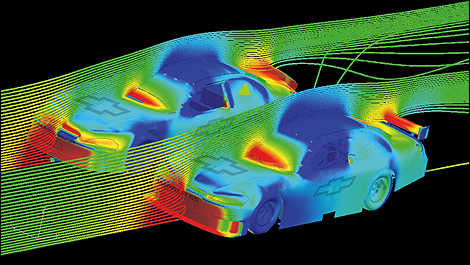Quote:
|
Originally Posted by color0
Now I have one thing to discuss: basic aerodynamic theory applied to 1/1 cars dictates that aerodynamics scale with speed squared, so low speed aero effects are almost negligible and at high speeds they are far dominant to suspension settings. The rear scoop wing (see Rune's Supra above) feels like it works that way, the effect is minimal at low speeds (~3mph) and rises sharply as the speeds climb (say, to 15mph). But the front diffuser does NOT seem to work like that. Its effect was noticeable at ALL speeds high and low, and only noticeably lost its effect at the slowest one or two turns on the track where I race. The front downforce feels like it's "kicked in" in the entire rest of the layout, both infield and high speed section. This is mathematically not impossible, I know that as objects get smaller, the aerodynamic effect has been known to possibly scale with speed instead of speed squared (look up Reynolds Number and Viscous Flow if you're knowledgeable and curious). But is that the effect I'm seeing with these cars? I have no idea, and I'm not about to BS that it is without confirming that it is.
Which is why we (GSR) are doing two things right now: 1) Building a wind tunnel to try and get some numbers on the aero devices installed on my car, and 2) Trying to get legitimate wind tunnel (hey, I'm a college student now!) time or simulation software to see if there is a way to visualize the airflow going through the shell. It's good stuff.
|
Idk about your college but ANSYS was available at mine. It's a pricey Analysis/CAE software it does amazing work though. I do know that you can program the fluid's properties (remember air is different at elevations).
As for the Aerodynamics comment, It took me a couple days to think about this and even discuss it with a friend of mine and we came to an agreement, and hopefully this helps give you a better understanding.
That agreement was this: When you apply Aero/Fluid dynamic theories, it's important to remember that "scale" is NOT something as simple as say having a 1:1 Impreza and having the 1:28th and saying the Coefficient of drag at 15 mph is proportionally the same. The best way (that we figured) to apply flow theory is to treat the Shell as its own object (in other words forget that its 1/28th and just say its a small object in a control region).
So say you're traveling at a slow speed (1 mph), picture it as everything but the car is moving (so the car is static and the air is coming to it at 1 mph). Everywhere on the shell thats perpendicular to the ground (90* with the ground) the Velocity of the air at the spot will be 0 (because air is hitting it and not deflecting so it's energy being absorbed by the car, aka drag). Now any surface thats angled will deflect the air, it won't deflect perfectly though there will be some drag and some flow. Once the air reaches the top of the angled surface (look at the top of the windshield in the pic of the airflow you posted, i'll post it below) the Velocity of the air actually increased because the deflection accelerated it.

This could help explain to you why a front deflector is working at all speeds, mind you that on a shell modeled after a real car all the "grills" are flat areas which would increase the drag force, by cutting out some of the areas that create drag and putting in something to deflect the air up (which pushes the body down), you're turning the drag force into down force.
As for the spoiler, well as flow passes an object (and you already looked up the reynolds number), the flow is interrupted and can become turbulent. In the pic you posted (I reposted above) you can see the the flap spoiler captures some of the air flowing past the car and as it passes it, the flow itself is becoming turbulent. The raised spoiler will actually capture and null (Velocity = 0) the flow hitting it to create a greater downforce. It's essentially a design of efficiency vs not using the air thats there.
Hopefully this all makes sense, the main point however is that a 1mph (low speed) drag/down forces would potentially have a strong force behind it due to such a small object. Surface area is key here, and I know Aero affects these cars because i've driven my Xmod Lan Evo VIII outdoors on windy days, and when a breeze, that is enough to slow my walking speed down, hits it, i really thought it would flip, but it didn't and even crosswinds couldn't.
Good luck with your research and wind tunnel.